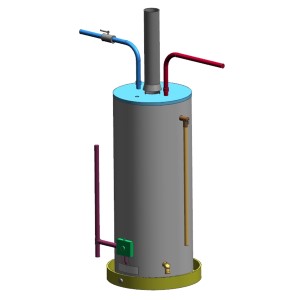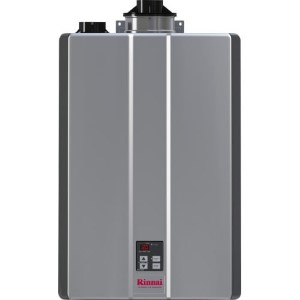- Home
- Water Tank Heater
- 5 Signs a Water Heater needs Replacement
5 Signs Your Water Heater is Going Out and needs Replacement
 Gas water heater
Gas water heaterHere we give you 5 signs your water heater is going out and needs replacement. You will find answers to questions such as - how do you know a water heater is going bad and when should I replace it? Or why my water heater is leaking, not working, or performing improperly?
If you have one of the following 5 signals, your water heater is either dead or about to die. You must act quickly and contact an experienced plumber.
5 signs your water heater is going out and about to fail
- Your water heater is going out because it is old
- Corrosion and the reason why your water heater fails
- Leaking problem
- Bulging and deformation
- Heavy sediment buildup and noise
Is your water heater going out because it is too old?
Check out the age of your water heater. If it is more than 10 years old, consider replacing it. According to experts, most water heater breakdowns begin to happen at the age of 10+ years.
If you are seeing a reduction in hot water supply, decreased energy efficiency, and increased energy costs, you might have a unit that is just too old and needs replacement.
This is how you can check the age of your water heater.
Find the manufacturer’s sticker or rating plate located on top of the unit or close to other stickers (warning labels and energy guide). It lists important info such as the serial number, model, fuel type, manufacture date (year), company’s name, capacity, BTU or wattage, etc.
Look for the serial number because some numbers or letters indicate the year when the water heater was built. Since the serial number format varies by the manufacturer, let’s check out the three of the most popular brands:
- AO Smith serial number – 1803*******. This unit was built in 2018 (18 is the year), week 3 (03 is the week).
- Rheem serial number – 1015*******. The unit was built in November (month-10), 2015 (year-15).
- Bradford White serial number – MA*******. This unit was built in January (month-A), 2015 (year-M).
This is how you decode BW manufacture date:
For a month: A represents January, B-February…. M-December
For a year: A represent 1984/2004, B-1985/2005,... T-1999/2019, W-2000, X-2001, Y-2002, Z-2003
The above can apply to the subsidiary companies as well.
Water heater manufacture age can also be found if you have a unit’s manual or simply checking it online or the manufacturer’s site.
Most tank-type water heaters have a 6-year warranty, and they usually last between 10 and 15 years. Some more, some less.
A water heater's life expectancy depends on many factors including the quality of installation and maintenance, water quality, usage, etc.
So, if your tank-type water heater is, let’s say 10 years old, you could expect some components falling apart, reduced efficiency and performance, or it would take too long to heat water.
If your water heater is old and you want to prevent future expensive breakdowns and significant damages to your property, start looking to buy and install a new high-efficiency unit. Better models come with 10-year warranties.
If you prefer on-demand heating and a continuous supply of hot water, consider tankless. Tankless water heaters last much longer, over 20 years, and the warranty is 15 years on better models. The longest warranty is found on Rinnai and Takagi models.
- Find Plumbers In Your Area -
Corrosion and rusty water can lead to a water heater failure
The first signs of corrosion on your water heater are rust on the heater’s shell, usually followed by leaks, and inside breakdowns followed by rusty hot water.
It is important to know that every tank-type water heater is equipped with the glass liner applied to the metal storage tank and anode rod, both working toward keeping corrosion away.
Due to imperfect manufacturing process, thermal stress, and chemical reaction, a glass liner can develop cracks, from tiny to large ones. This is where water gets in contact with the metal tank, and over time develops rust.
The anode rod is another layer of protection, a metal tube that deteriorates over time. It is also known as the sacrificial rod, as it sacrifices itself to protect the tank.
As the anode rod weakens, it loses its ability to protect, making the metal tank prone to quicker corrosion. The best water heaters usually have one or two heavy-duty anodes or a powered rod.
Tip 1: Make sure to inspect the anode rod as recommended by the manufacturer, but at least once annually, and replace it if necessary.
To check if there is inner corrosion, attach the garden hose to the drain valve located at the bottom of the heater, and drain a few gallons of water. If your water has a rusty, muddy look and metallic taste, you have a corrosion problem. It takes only several years for a water heater to show the first signs of corrosion.
Tip 2: Ensure to drain your water heater yearly and flush out mineral deposits and sediment buildup.
There is no easy way to fix corrosion, and it is not recommended. It always spreads and leads to leaking and property damage. If some components are affected, they can be replaced, but you have to be careful as other parts might start rusting.
For example, when copper and steel parts are connected, an electrochemical reaction occurs, leading to corrosion.
Tip 3: This can be prevented by using dielectric fittings made of galvanized steel and equipped with the inner plastic tube.
Leaks that cannot be fixed
Here we are talking about water heater leaking that is hard or impossible to fix, but not drips from the plumbing or lose connections.
The first sign of a leak is a puddle of water collected under the heater. The real problem is a serious leak that could damage your property. If your water heater is located in the basement, damages are not as bad as if the unit is installed in the attic or on the same level as your living room.
As mentioned in the above text, if your water heater is leaking because your heater has a rupture caused by corrosion or mechanical stress, have your tank replaced right away by an experienced professional. Keep in mind that when a fracture first develops, the gap is tiny, but as time goes by and the tank is exposed to many cycles and thermal stress, a small leak becomes noticeable and hard to repair and control.
Any leak should be treated and fixed on time, not only due to damages on the surrounding objects and personal belongings but due to mold and mildew growth and health risk in general.
Bulging water heater and excessive internal pressure
A bulging water heater is a serious problem when there is excessive pressure inside the water tank, especially if it is part of the closed system. Another reason is the blockage.
Typical symptoms are deformations such as cockeyed nipples, reversed bottom or top of the unit, dislocated flue pipe, and leaking. A water heater that is deformed cannot be repaired – it has to be replaced. But, it can be prevented by installing the unit properly, such as installing the expansion tank.
If left untreated, a water heater can burst.
Heavy sediment buildup and strange noise
If your water heater is acting differently, such as low performance, not as efficient, your bills are high, takes time to heat water, hard to drain, or making a strange noise (such as rumbling, knocking, or popping sound), you should inspect a unit for sediment buildup especially if you haven’t flush the unit recently.
Sediment buildup is the problem that almost every water heater located in the area with hard water would suffer, sooner or later. Due to the mineral content inside water, sediments start to form on the bottom of the tank and some components. Over time the buildup grows and hardens, making a thick insulator between the heat source and water, leading to many problems.
As suggested by all manufacturers and experts, flushing the water heater regularly is one of the methods recommended to prevent the buildup.
If you require professional assistance, contact your local water heater expert! Get FREE estimates here!
New water heater installation prices
Here we have listed only a few but major problems that can tell you when your water heater is going out. And when the time comes to replace an old or broken unit, you have to start searching for a new heating device and start collecting quotes.
Installation prices for a new water heater vary from region to region and from contractor to contractor.
If we look at the numbers published by homeadvisor.com, we will see that the average cost to replace a water heater is $1168, and the typical range is from $805 to $1554.
Installation costs for the tank-type water heaters range from $150 to $600, while for the tankless water heaters is from $400 to $1500.
You can also a calculator, found on the same site, to see the prices in your city.
Conclusion
Every water heater develops problems, some sooner and some later. In order to keep the unit functioning and extend life, proper maintenance is vital.
If your water heater is going out, does not function, and is beyond repair, as explained in this article, you need to contact a licensed technician to install a new water heating system.
Related
- Home
- Water Tank Heater
- 5 Signs a Water Heater needs Replacement



